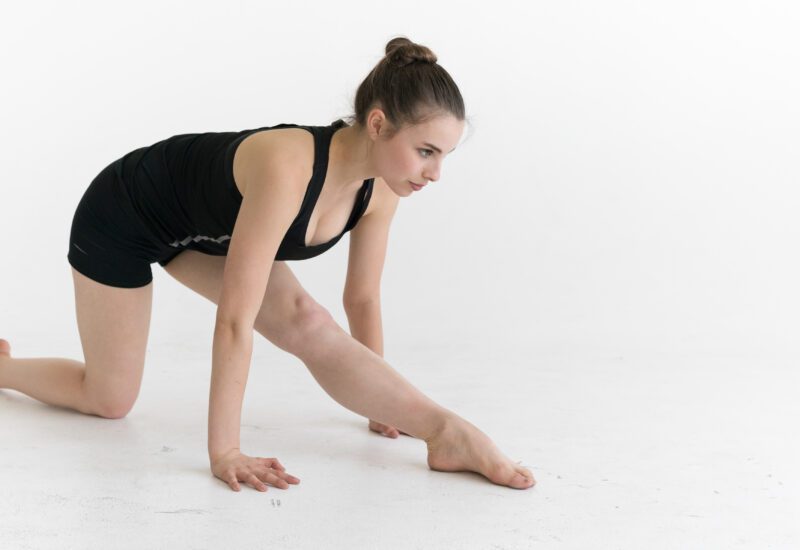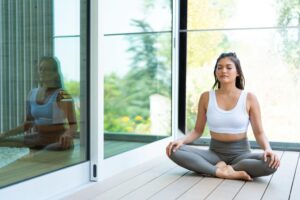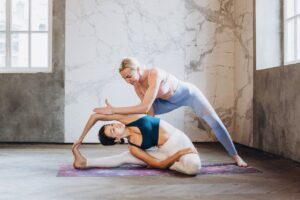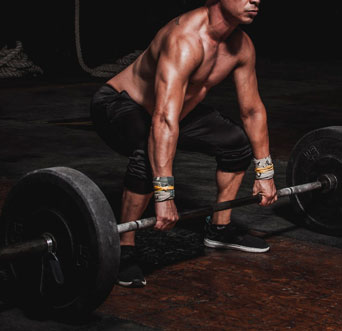The best stretches for flexibility include hamstring stretches, hip stretches, and shoulder stretches. These stretches help improve range of motion and increase flexibility in the targeted muscles.
Additionally, regular stretching can help prevent injuries and improve athletic performance. By incorporating these stretches into your daily routine, you can enhance your flexibility and overall fitness level.

Credit: naturallysassy.co.uk
Benefits Of Flexibility
Flexibility refers to the ability of your muscles and joints to move through a full range of motion. Incorporating stretches for flexibility into your fitness routine can offer several significant benefits. Let’s explore some of the key advantages below:
Improved Range Of Motion
Maintaining good flexibility helps improve your range of motion, allowing you to move freely and perform various activities with ease. Here are the benefits associated with improved range of motion:
- Increased joint mobility: Stretching regularly can enhance the flexibility of your joints, which is beneficial for activities that require bending, twisting, or reaching.
- Fluid movements: Having a wider range of motion allows you to perform exercises, sports, and everyday tasks smoothly and effortlessly.
- Prevention of muscle imbalances: Stretching the muscles surrounding your joints can help correct any imbalances, ensuring proper alignment and reducing the risk of chronic pain.
Enhanced Athletic Performance
Flexibility plays a vital role in optimizing athletic performance across different sports. Regular stretching can contribute to the following advantages:
- Increased agility and speed: Flexible muscles and joints enable quick and agile movements, enhancing speed and agility in various athletic activities.
- Improved muscle coordination: Stretching promotes better coordination among your muscles, facilitating efficient movement patterns.
- Enhanced power and strength: Maintaining good flexibility allows you to maximize the force applied during movements, leading to improved power and strength.
Prevention Of Injuries
Regular stretching plays a crucial role in injury prevention by preparing your muscles and joints for physical activities. Here’s how flexibility helps prevent injuries:
- Increased muscle elasticity: Flexible muscles are less prone to strains and tears, as they can withstand sudden movements or stress without getting injured.
- Improved posture and alignment: Stretching enhances muscle balance, promoting better posture and reducing the risk of muscle imbalances that can lead to injuries.
- Enhanced circulation: Stretching helps improve blood flow to your muscles, supplying them with oxygen and nutrients, which aids in injury prevention and promotes faster recovery.
Remember, incorporating a variety of flexibility exercises into your workout routine and stretching all major muscle groups is essential for reaping the numerous benefits of flexibility. So, don’t forget to include stretches that target different areas of your body for overall flexibility and improved physical performance.
Stay flexible, stay fit!
Stretching Basics
Stretching is an essential component of any exercise routine. Not only does it help increase flexibility, but it also plays a crucial role in preventing injuries. In this section, we will discuss the stretching basics that will set a solid foundation for improving your flexibility.
Understanding different stretching techniques and the importance of warm-up exercises will ensure that you get the most out of your stretching routine.
Understanding Different Stretching Techniques
- Static stretching: This is the most common type of stretching where you hold a stretch for a certain amount of time, usually around 30 seconds. It helps improve flexibility by elongating the muscles and increasing their range of motion.
- Dynamic stretching: Unlike static stretching, dynamic stretching involves moving parts of your body through a full range of motion in a controlled manner. This type of stretching is great for warming up before physical activity as it mimics the movements you will be performing during the activity.
- Pnf stretching: Pnf stands for proprioceptive neuromuscular facilitation, which is a technique that combines stretching and contracting muscles. By alternating between stretching and contracting, you can target specific muscle groups and increase their flexibility.
Importance Of Warm-Up Before Stretching
A proper warm-up is vital before starting any stretching routine. It not only prepares your body for the physical activity ahead but also reduces the risk of injury. Here are some key points to keep in mind when warming up:
- Increased blood flow: A warm-up session gets your heart pumping and increases blood flow to your muscles, supplying them with oxygen and nutrients. This helps prevent muscle cramps and enhances performance.
- Improved joint mobility: As your body warms up, your joints become more lubricated, allowing for smoother and more fluid movements.
- Enhanced muscle elasticity: Warm-up exercises gradually increase the temperature of your muscles, making them more pliable and less prone to strains or tears.
- Mental preparedness: A warm-up not only prepares your body physically but also helps mentally transition into the workout ahead. It allows you to focus on your goals and mentally prepare for the stretching routine.
Incorporating these stretching basics into your fitness routine will help you improve flexibility and decrease the risk of injuries. Remember to utilize different stretching techniques and always warm up properly before diving into your stretching routine. So, let’s stretch our way to better flexibility!
Upper Body Stretches
Keeping your upper body flexible is essential for maintaining good posture, reducing muscle tension, and preventing injuries. Incorporating regular stretches into your routine can help improve flexibility in your neck, shoulders, chest, back, arms, and wrists. Here are some effective upper body stretches that can be easily incorporated into your daily routine:
Neck And Shoulder Stretches
Neck and shoulder stretches can help relieve tension and improve flexibility in these areas. Here are a few key stretches to try:
- Neck tilt: Gently tilt your head to the right, bringing your right ear towards your shoulder. Hold for 15-20 seconds and repeat on the left side. This stretch targets the neck muscles.
- Shoulder rolls: Roll your shoulders in a circular motion, starting from a relaxed position, moving them forward, up, back, and down. Repeat for 10-15 seconds in each direction. This stretch helps to loosen up tight shoulder muscles.
- Upper trapezius stretch: Tilt your head towards one shoulder, then gently use your hand to apply slight pressure on the opposite side of your head, bringing your ear closer to your shoulder. Hold for 15-20 seconds and repeat on the other side. This stretch targets the upper trapezius muscles in your neck and shoulders.
Chest And Back Stretches
Stretching your chest and back muscles can help improve posture and relieve tightness. Incorporate these stretches into your routine:
- Chest opener: Stand with your feet shoulder-width apart, interlace your fingers behind your back, and gently squeeze your shoulder blades together while lifting your hands away from your body. Hold for 15-20 seconds. This stretch opens up the chest muscles.
- Cat-cow stretch: Start on all fours with your hands directly under your shoulders and your knees under your hips. As you inhale, arch your back and lift your head, allowing your belly to sink towards the floor (cow pose). As you exhale, round your back and tuck your chin towards your chest (cat pose). Repeat for 5-10 cycles. This stretch targets both the chest and back muscles.
Arm And Wrist Stretches
Stretching your arms and wrists can help alleviate tension and increase flexibility in these areas. Here are a few stretches to incorporate:
- Triceps stretch: Extend one arm overhead and bend at the elbow, bringing your hand towards the opposite shoulder blade. Use your other hand to gently push your elbow towards your head. Hold for 15-20 seconds and repeat on the other side. This stretch targets the triceps muscle.
- Wrist flexor and extensor stretch: Extend one arm forward with your palm facing down, then use your opposite hand to gently bend your wrist downward, feeling a stretch in the underside of your forearm. Hold for 15-20 seconds and repeat on the other side. Next, extend your arm forward with your palm facing up, use your opposite hand to gently bend your wrist upward, feeling a stretch in the top of your forearm. Hold for 15-20 seconds and repeat on the other side. These stretches target the wrist flexors and extensors.
Remember to perform these stretches in a controlled manner, without bouncing or forcing the movement. Start with gentle stretches and gradually increase the intensity over time. Always listen to your body and stop if you feel any pain or discomfort.
Incorporating these upper body stretches into your routine can help improve flexibility and overall well-being.
Lower Body Stretches
Hip And Glute Stretches
Stretching the hips and glutes is essential for improving flexibility in the lower body. Here are some key stretches to incorporate into your routine:
- Pigeon pose: Start in a push-up position, bring your right knee forward, and place it behind your right wrist. Extend your left leg behind you and lower your body down, resting on your forearms. Hold for 30 seconds to a minute, then switch sides.
- Figure four stretch: Lie on your back with both knees bent. Place your right ankle on your left thigh, just above the knee. Reach through and grab the back of your left thigh, and gently pull it towards your chest. Hold for 30 seconds to a minute, then switch sides.
- Butterfly stretch: Sit on the floor with the soles of your feet touching each other. Keep your back straight and gently press your knees towards the floor using your hands. Hold for 30 seconds to a minute.
- Seated forward bend: Sit with your legs extended in front of you. Reach forward and grab your feet or ankles, then slowly lower your torso towards your legs. Hold for 30 seconds to a minute.
- Lunging hip flexor stretch: Start in a lunge position with your right knee bent and your left leg extended behind you. Shift your weight forward and slightly lean your torso back, feeling the stretch in your left hip flexor. Hold for 30 seconds to a minute, then switch sides.
Quadriceps And Hamstring Stretches
Keeping the quadriceps and hamstrings flexible is crucial for maintaining lower body mobility. Here are some effective stretches for these muscle groups:
- Standing quadriceps stretch: Stand upright and grab your right ankle with your right hand. Pull your ankle towards your glutes, feeling the stretch in your right quadriceps. Hold for 30 seconds to a minute, then switch sides.
- Standing hamstring stretch: Stand with your feet hip-width apart and extend your right leg in front of you. Hinge forward at the hips, keeping your back straight, and reach towards your right foot. Hold for 30 seconds to a minute, then switch sides.
- Supine hamstring stretch: Lie on your back with both legs extended. Lift your right leg towards the ceiling, keeping it straight, and grab behind your thigh or calf. Gently pull your leg towards your upper body, feeling the stretch in your hamstring. Hold for 30 seconds to a minute, then switch sides.
- Standing forward bend: Stand with your feet hip-width apart and hinge forward at the hips, reaching towards your toes. Keep your knees slightly bent to protect your hamstrings. Hold for 30 seconds to a minute.
Calf And Ankle Stretches
The calf muscles and ankles play a vital role in lower body movement, so it’s important to stretch and maintain their flexibility. Here are a few effective stretches:
- Calf stretch: Stand facing a wall and place your hands against it. Step your right foot back and press your right heel into the ground, keeping your right leg straight. Lean your body weight forward, feeling the stretch in your right calf. Hold for 30 seconds to a minute, then switch sides.
- Downward dog: Start in a push-up position with your hands slightly wider than shoulder-width apart. Press your hips up and back towards the ceiling, lengthening your spine and straightening your legs. Feel the stretch in your calves and ankles. Hold for 30 seconds to a minute.
- Ankle circles: Sit on the edge of a chair or a bench and extend one leg in front of you. Rotate your ankle in a circular motion, clockwise and counterclockwise. Repeat for 10 to 15 circles, then switch sides.
- Heel drop: Stand on the edge of a step or a curb, with your heels hanging off the edge. Slowly lower your heels towards the ground, feeling the stretch in your calves. Hold for 30 seconds to a minute.
Incorporating these lower body stretches into your fitness routine can greatly improve your flexibility and help prevent muscle imbalances or injuries. Remember to listen to your body and stretch within your comfort zone. Stay consistent, and you’ll soon notice the benefits of a more limber lower body.
Yoga Poses For Flexibility
Yoga poses are not only great for stretching and strengthening the body, but they also help improve flexibility. Incorporating these poses into your daily routine can increase your range of motion and promote a limber and agile body. Here are three yoga poses that are particularly effective for improving flexibility:
Downward Dog Pose
- Start on all fours, with your hands placed shoulder-width apart and your knees directly under your hips.
- Press your palms firmly into the ground, tuck your toes, and lift your knees off the floor, straightening your legs.
- Push your hips up and back, creating an upside-down “v” shape with your body.
- Keep your heels grounded as much as possible while lengthening your spine and relaxing your neck.
- Engage your core muscles and breathe deeply, holding the pose for 30 seconds to 1 minute.
Triangle Pose
- Stand with your feet hip-width apart and extend your arms out to the sides, parallel to the ground.
- Turn your right foot out 90 degrees and align your right heel with the arch of your left foot.
- Inhale and reach your right arm towards the right side, while simultaneously extending your left arm straight up.
- Exhale and hinge at the hips, extending your torso to the right and placing your right hand on your shin, ankle, or the floor.
- Keep both legs straight and maintain a long, neutral spine.
- Hold the pose for 30 seconds to 1 minute, then switch sides.
Butterfly Pose
- Sit on the floor with legs extended in front of you.
- Bend your knees and bring the soles of your feet together, allowing your knees to fall out to the sides.
- Holding onto your feet or ankles, gently flap your legs up and down like butterfly wings.
- Keep your spine straight and allow your hips to open up.
- Take deep breaths and hold the pose for up to 1 minute.
Incorporating these yoga poses into your regular stretching routine can significantly enhance your flexibility over time. Remember to listen to your body and never push yourself beyond your limits. With consistent practice and patience, you’ll gradually improve your flexibility and enjoy the benefits of a more supple and agile body.
So, roll out your yoga mat and embrace the journey towards greater flexibility!
Pilates Exercises For Flexibility
If you’re looking to increase your flexibility and strengthen your muscles at the same time, pilates exercises can be a great option. Pilates focuses on core strength, but it also helps to improve flexibility and balance. Here are three pilates exercises that can help you increase your flexibility:
Roll-Up Exercise:
- Lie on your back with your arms extended overhead, and your legs straight in front of you.
- Inhale as you begin to roll your spine up, one vertebra at a time, reaching your fingers toward your toes.
- Exhale as you slowly roll back down to the starting position, continuing to articulate your spine.
- Repeat this movement for 8-10 repetitions.
Spine Twist Exercise:
- Sit up tall with your legs extended in front of you and your arms out to the sides.
- Inhale as you rotate your torso to the right, keeping your pelvis stable.
- Exhale as you rotate your torso to the left, focusing on stretching through the spine.
- Repeat this exercise for 8-10 repetitions on each side.
Swan Exercise:
- Lie on your stomach with your legs extended and your hands positioned underneath your shoulders.
- Inhale as you lift your upper body off the mat, extending your spine and reaching your fingertips forward.
- Exhale as you lower your upper body back down, lengthening and stretching the spine.
- Repeat this movement for 8-10 repetitions, focusing on engaging your back muscles.
Incorporating these pilates exercises into your fitness routine can help you improve your flexibility and mobility. Remember to listen to your body and work within your limits, gradually increasing the intensity and range of motion as you become more comfortable with the exercises.
So, roll up, twist your spine, and gracefully dive into the world of pilates for improved flexibility.
Stretching For Specific Activities
Stretching is an essential component of any fitness routine, as it helps improve flexibility, prevent injuries, and increase range of motion. When it comes to stretching, different activities require specific stretches to target the muscles and movements used in those activities.
In this section, we will explore the best stretches for runners, weightlifters, and dancers to enhance their performance and ensure optimal flexibility.
Stretching For Runners
Running puts a lot of stress on the lower body, particularly the muscles in the legs and hips. Stretching before and after running can help warm up the muscles, reduce tightness, and improve overall performance. Here are some key stretches that runners should incorporate into their routine:
- Quad stretch: Stand tall and bring one heel towards your buttocks, holding onto it with your hand. Hold the stretch for 30 seconds on each leg.
- Hamstring stretch: Sit on the ground with one leg straight in front of you and the other bent with the sole of your foot against your inner thigh. Reach forward towards your toes, keeping your back straight. Hold for 30 seconds on each leg.
- Calf stretch: Stand facing a wall with one foot forward and the other foot back. Lean forward, keeping your back leg straight and pressing your heel into the ground. Hold the stretch for 30 seconds on each leg.
- Hip flexor stretch: Begin in a lunge position with one knee on the ground and the other bent at a 90-degree angle. Lean forward, keeping your back straight, until you feel a stretch in the front of your hip. Hold for 30 seconds on each leg.
Stretching For Weightlifters
Weightlifting requires strength and stability, but flexibility is equally important to perform lifts correctly and prevent muscle imbalances. Incorporating specific stretches into your routine can help improve your range of motion and protect against common weightlifting injuries. Here are some key stretches for weightlifters:
- Shoulder stretch: Stand tall and cross one arm in front of your body, using your other arm to gently pull it closer to your chest. Hold for 30 seconds on each side.
- Chest stretch: Stand with your arms outstretched to the side at shoulder height. Rotate your shoulders backward, squeezing your shoulder blades together. Hold for 30 seconds.
- Hip opener stretch: Sit on the ground with one leg straight and the other bent with the foot against your inner thigh. Lean forward, reaching towards your toes, and hold for 30 seconds on each side.
- Triceps stretch: Extend one arm overhead and bend your elbow, reaching your hand towards the opposite shoulder blade. Use your other hand to gently press the elbow closer to your head. Hold for 30 seconds on each side.
Stretching For Dancers
Dancing demands a high level of flexibility and mobility to perform various movements with grace and ease. Proper stretching is crucial for dancers to improve their technique, prevent injuries, and maintain optimal range of motion. Here are some key stretches for dancers:
- Straddle stretch: Sit on the ground and spread your legs as wide as possible. Lean forward by bending at the hips, reaching towards the middle and then both sides. Hold for 30 seconds.
- Hip flexibility stretch: Lie on your back with one leg extended straight up towards the ceiling and the other extended straight on the ground. Gently pull the raised leg towards your chest until you feel a stretch in the hip. Hold for 30 seconds on each leg.
- Back extension stretch: Lie on your stomach with your hands placed beside your shoulders. Push up, arching your back while keeping your hips on the ground. Hold for 30 seconds.
- Ankle stretch: Sit on the ground with your legs stretched out in front of you. Flex one foot, pointing your toes towards your body, and use your hand to gently push your toes back. Hold for 30 seconds on each foot.
Incorporating these targeted stretches into your pre- and post-workout routines can greatly benefit runners, weightlifters, and dancers by improving flexibility, reducing the risk of injury, and optimizing performance. Remember to always listen to your body and stretch within a comfortable range of motion.
Stay flexible, stay injury-free!
Tips For An Effective Stretching Routine
Stretching is an essential part of any fitness routine and can help improve flexibility, prevent injury, and promote overall well-being. However, in order to get the most out of your stretching routine, there are a few key tips to keep in mind.
Whether you’re a beginner or a seasoned stretcher, these guidelines will ensure that you’re getting the most effective stretch possible.
Setting Realistic Goals
When starting a stretching routine, it’s important to set realistic goals for yourself. This will not only keep you motivated, but also help you track your progress over time. Here are some key points to consider when setting goals:
- Start small and gradually increase your stretching time and intensity.
- Be specific with your goals, such as being able to touch your toes or perform a certain yoga pose.
- Set a timeline for achieving your goals, whether it’s weeks or months.
- Celebrate milestones along the way to keep yourself motivated.
Staying Consistent With Stretching
Consistency is key when it comes to stretching. In order to see progress and maintain flexibility, it’s important to incorporate stretching into your daily routine. Here’s how you can stay consistent with your stretching:
- Schedule stretching sessions at the same time each day to create a habit.
- Start with shorter stretching sessions if you’re pressed for time, but make sure to still prioritize it.
- Consider incorporating stretching into activities you already enjoy, such as watching tv or listening to music.
- Find a stretching routine that you enjoy and switch it up to keep things interesting.
Listening To Your Body And Avoiding Overstretching
While it’s important to challenge yourself during stretching, it’s equally important to listen to your body and avoid overstretching. Here are some tips to help you find the balance:
- Pay attention to how your body feels during stretches. Discomfort is normal, but pain is not.
- Avoid bouncing or jerking movements during stretches, as this can lead to injury.
- Take deep breaths and relax into each stretch to allow your muscles to release tension.
- If a stretch feels too intense, back off and try a modified version until you build up more flexibility.
Remember, everyone’s flexibility levels are different, so it’s important to respect your own limitations and progress at your own pace. By setting realistic goals, staying consistent, and listening to your body, you can create an effective stretching routine that will help you reach new levels of flexibility and overall well-being.
So, go ahead and start stretching your way to a more limber body!
Frequently Asked Questions Of Best Stretches For Flexibility
What Are The Best Stretches For Flexibility?
Some of the best stretches for flexibility include hamstring stretches, hip flexor stretches, and shoulder stretches.
How Often Should I Stretch For Flexibility?
It is recommended to regularly stretch for flexibility at least 2-3 times per week.
Will Stretching Help Me Improve My Athletic Performance?
Yes, regular stretching can improve athletic performance by increasing flexibility, range of motion, and reducing the risk of injuries.
Can Stretching Help Relieve Muscle Tightness?
Yes, stretching helps relieve muscle tightness by increasing blood flow to the muscles and promoting relaxation.
Conclusion
To wrap up, incorporating regular stretching exercises into your fitness routine is essential for enhancing flexibility. These stretches not only help improve your overall range of motion but also contribute to better posture and increased muscle relaxation. The variety of stretches mentioned in this blog post cater to different muscle groups, ensuring a well-rounded approach to flexibility training.
Remember to always warm up before stretching and hold each stretch for at least 15-30 seconds to allow your muscles to properly elongate. Additionally, consistency is key when it comes to improving flexibility, so aim to incorporate these stretches into your routine at least 2-3 times a week.
By making flexibility a priority, you will better prepare your body for physical activities and reduce the risk of muscle strains or injuries. Start implementing these stretches today and experience the benefits of improved flexibility in your everyday life.




